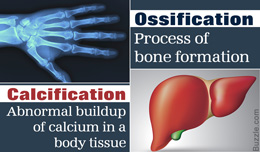While ossification refers to the process of bone formation, calcification usually indicates that calcium has accumulated unnaturally in various tissues of the body. This Buzzle post includes an ossification vs. calcification comparison in detail.

Did You Know?Osteoblasts, osteoclasts, and osteocytes, are the 3 types of cells that play an important role in bone formation and maintenance.Contrary to popular belief, ossification and calcification are two different processes that occur in our body. Both these processes are important for bone synthesis. However, calcification that has been linked to abnormally high calcium levels in the blood cannot be ignored and requires treatment ASAP to prevent any complications.
Around 99% of calcium obtained from the food goes to our bones, while the rest circulates in our bloodstream. However, if this 1% calcium starts depositing in various body tissues, it can cause various health problems. These are discussed below.Ossification Vs. CalcificationWhat is it?
Ossification
Ossification refers to the mechanism of bone development. In short, it is a process by which bone growth takes place. This process continues even after the child attains adulthood. Ossification plays a crucial role in the healing of fractures.
Calcification
Calcification refers to the unnatural deposition of calcium in various tissues of the body. Since bones also contain calcium, the process of calcification is also an integral part of bone growth and development. Calcium is usually absorbed by the bones and the teeth but when it starts accumulating in other areas of the body, it is a cause for great concern.Types
Ossification
Endochondral ossification is a process in which the soft cartilage slowly converts into bone. The short, long, and irregular bones are developed by endochondral ossification. On the other hand, in intramembranous ossification, bones develop from connective tissue sheets that are full of osteoblast cells. This process is responsible for the formation of flat bones such as those located on the skull.
Calcification
Classification is based on the underlying cause. Dystrophic calcification occurs even when there is no increase in blood calcium levels. It arises due to tissue damage. Metastatic calcification occurs due to fluctuations in calcium and phosphorus levels in the blood.Causes
Ossification
It is a natural process of the body in which soft tissues turn into a bony substance. However, in some cases, bone development occurs beyond the confines of the skeleton, which is commonly referred to as heterotopic ossification. This abnormal growth of bone tissue has often been attributed to serious fractures of the long bones. Severe burns, neurological disorders, and spinal cord injuries are the other factors that can cause heterotopic ossification.
Calcification
Calcification of soft tissues has been attributed to vitamin K inadequacy and abnormally high levels of vitamin D circulating in the bloodstream. Vitamin D is known to facilitate calcium absorption; hence when it is present in elevated amounts, it can cause calcification. On the other hand, adequate vitamin K is important to keep calcium from accumulating in other tissues of the body. So vitamin K deficiency is often responsible for causing calcification in body tissues.Consequence
Ossification
The absence of ossification means our body would have no toughness or hardness. The body would be lacking in musculoskeletal system. As a result, our body would essentially be a structure of flesh, water, and blood.
Calcification
Calcium buildup can interfere with the normal functioning of a specific organ, depending upon which part of the body it has affected. For instance, calcification of kidneys can lead to formation of kidney stones. When it affects the arteries of the heart, it can lead to a heart attack. Whereas, liver calcification can severely impair digestion.


 Did You Know?Osteoblasts, osteoclasts, and osteocytes, are the 3 types of cells that play an important role in bone formation and maintenance.Contrary to popular belief, ossification and calcification are two different processes that occur in our body. Both these processes are important for bone synthesis. However, calcification that has been linked to abnormally high calcium levels in the blood cannot be ignored and requires treatment ASAP to prevent any complications.
Did You Know?Osteoblasts, osteoclasts, and osteocytes, are the 3 types of cells that play an important role in bone formation and maintenance.Contrary to popular belief, ossification and calcification are two different processes that occur in our body. Both these processes are important for bone synthesis. However, calcification that has been linked to abnormally high calcium levels in the blood cannot be ignored and requires treatment ASAP to prevent any complications.